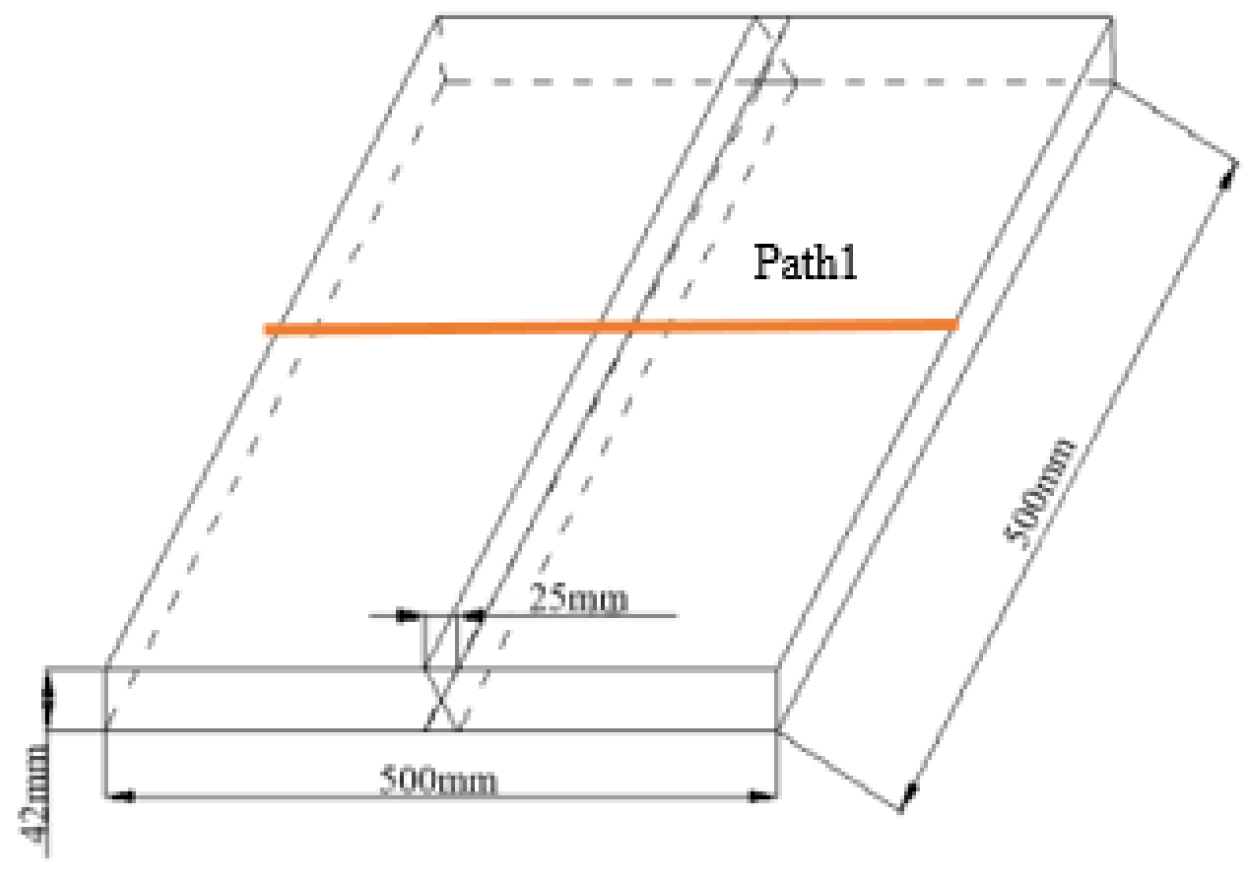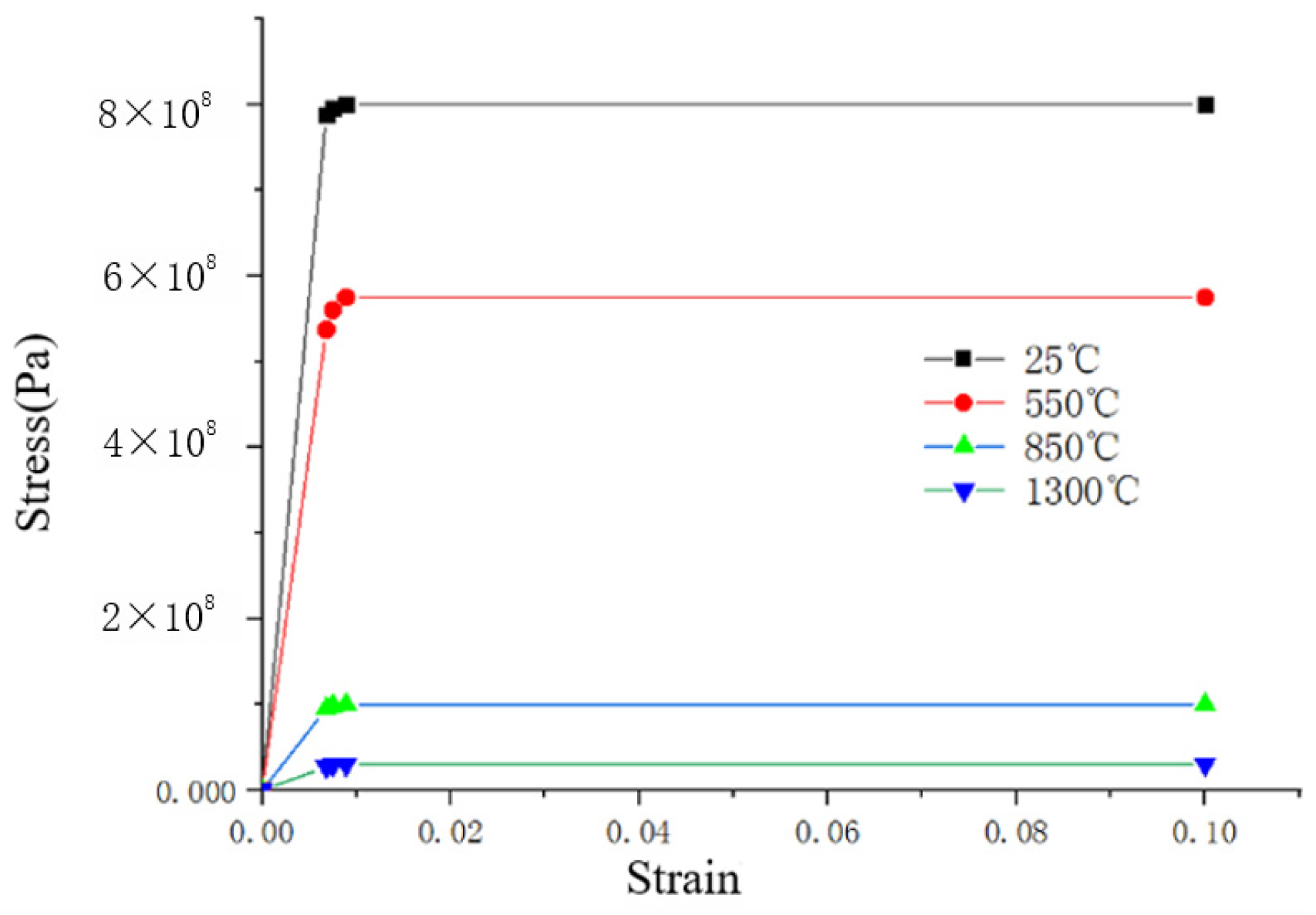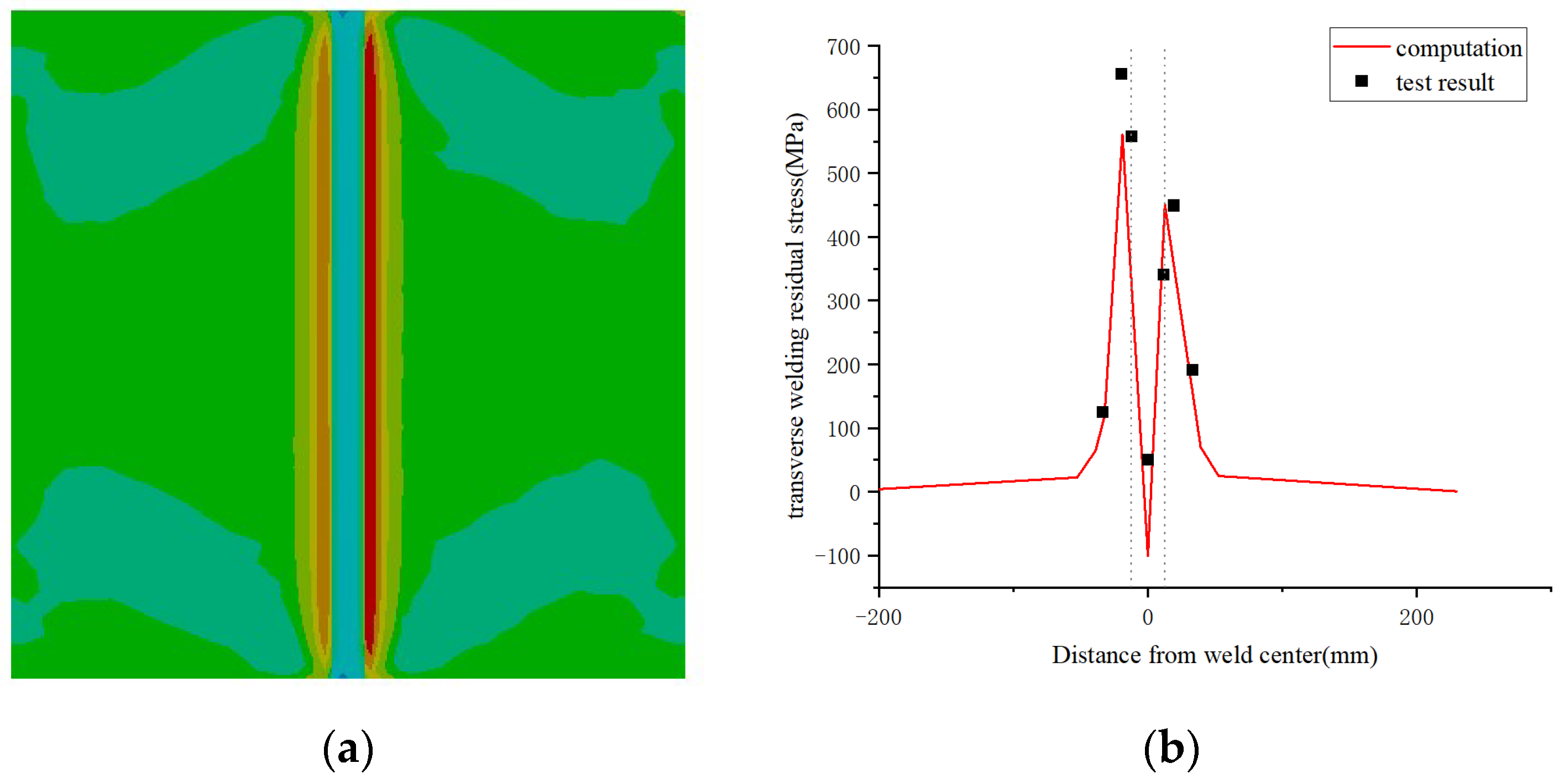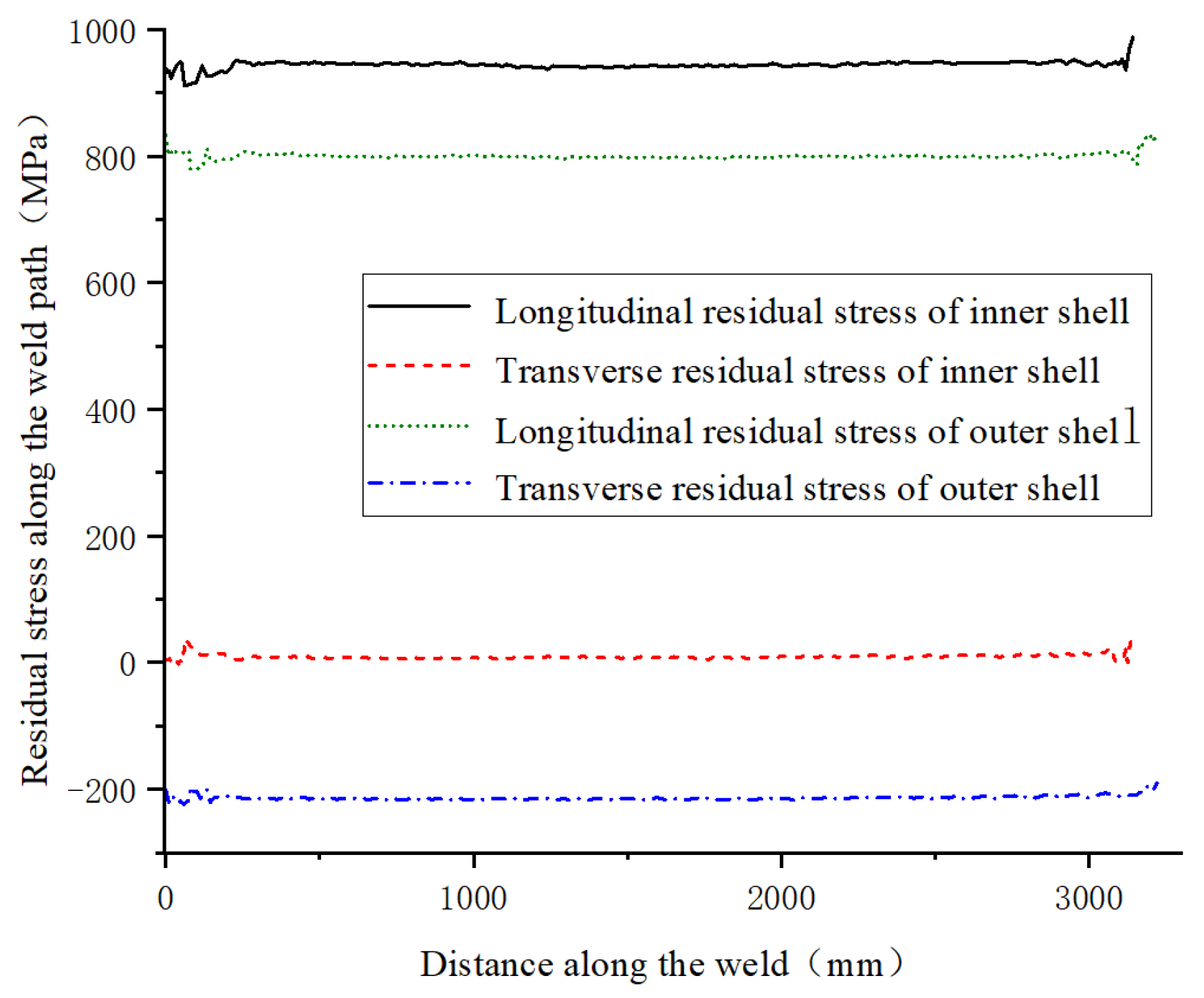Effect of Residual Stress on the Ultimate Bearing Capacity of Titanium Alloy Pressure Spherical–Cylindrical-Combined Shells
Abstract
:1. Introduction
2. Theory and Methods
2.1. Finite Element Analysis of Welding Residual Stress
- The sequential coupling analysis is conducted to simulate an instantaneous temperature field change in the welding process.
- A temperature field is introduced into the model as an external load, and the stress and strain of the structure are simulated to obtain the residual stress.
2.2. Nonlinear Ultimate Bearing Capacity of the Structure
- Material nonlinearity: Considering the plastic behavior of the material, the stress–strain relationship of the material changes with increasing stress. When the local yield of the structure occurs, the material enters its plastic state, and the stress–strain relationship no longer remains linear.
- Geometric nonlinearity: The structure undergoes considerable deformation under loading; therefore, the original equilibrium equation derived based on the small-deformation theory is no longer valid. Consequently, a new equation must be established based on the real-time state of the structure after deformation.
3. Results: Welding Residual Stress
3.1. Verification of Residual Stress of the Titanium Alloy Butt-Welding Plate
3.1.1. Finite Element Model
3.1.2. Material Properties
3.1.3. Welding Process and Related Parameters
3.1.4. Numerical Simulation of Welding Residual Stress
3.2. Welding Residual Stress of Titanium Alloy Pressure Spherical–Cylindrical-Combined Shells
3.2.1. Geometric Model
3.2.2. Finite Element Model and Boundary Conditions
3.2.3. Material Properties
3.2.4. Simulation Results and Analysis of Welding Residual Stress
- A large residual tensile stress existed near the weld on Path 2, and the transverse residual stress exhibited a bimodal distribution. The maximum tensile stress was approximately 170 MPa, which was approximately 20% of the yield strength of the material. The longitudinal residual tensile stress was high, and the maximum value was approximately equal to the yield strength.
- The longitudinal residual stress near the weld on Path 3 had a high tensile stress; the maximum value was approximately 780 MPa, and the transverse residual stress near the weld was compressive stress.
- Along Paths 4 and 5, both the inner and outer shells showed large longitudinal residual tensile stress, whereas the transverse residual tensile stress of the inner shell was small, and that of the outer shell was compressive stress.
- The von Mises residual stress on Paths 2 and 3 perpendicular to the weld direction was larger in the weld part, whereas that on Paths 4 and 5 along the weld direction was larger.
4. Discussion: Effect of Welding Residual Stress on Ultimate Bearing Capacity
4.1. Ultimate Bearing Capacity of Shells without Considering the Influence of Residual Stress
4.2. Ultimate Bearing Capacity of Ttitanium Alloy Pressure Spherical–Cylindrical-Combined Shell Considering Welding Residual Stress
5. Conclusions
- The transverse residual stress on the surface of the inner shell of the titanium alloy pressure spherical–cylindrical combined shell has a bimodal distribution that reaches approximately 20% of the yield strength, and the longitudinal residual tensile stress is higher than the transverse residual tensile stress. The longitudinal residual tensile stress near the weld on the shell surface perpendicular to the weld path is higher, whereas the transverse residual stress is close to the compressive stress.
- The surfaces of the inner and outer shells of titanium alloy pressure spherical–cylindrical-combined shells along the weld direction exhibit a large longitudinal residual tensile stress, and the transverse residual stress of the inner shell is small, whereas the outer shell exhibits residual compressive stress.
- Owing to the characteristics of the ring structure and cooling shrinkage of the girth weld during manufacturing, the additional bending moment and stress perpendicular to the direction of the girth weld are relatively prominent, and tensile and compressive stresses exist simultaneously.
- The welding residual stress has little effect on the ultimate bearing capacity of the titanium alloy pressure spherical–cylindrical composite shell’s structure.
Author Contributions
Funding
Data Availability Statement
Conflicts of Interest
References
- Busby, R.F. Manned Submersibles; Office of the Oceanographer of the Navy: Washington, DC, USA, 1976. [Google Scholar]
- Li, G.; Wang, Y.; Liang, Y.; Gao, P.; Liu, X.; Xu, W.; Yang, D. Microstructure and mechanical properties of laser welded Ti-6Al-4V (TC4) titanium alloy joints. Opt. Laser Technol. 2024, 170, 110320. [Google Scholar] [CrossRef]
- Gong, H.; Liu, M.; Zhang, T.; He, Y.; Wu, Y.; Yu, Z. Study on residual stress and optimization of welding parameters in linear friction welding of TC17 titanium alloy. Materials 2022, 15, 8963. [Google Scholar] [CrossRef] [PubMed]
- Kumar, B.; Bag, S.; Amin, M.R. Evaluation of phase Transformation strain and its influence on residual stress generation in laser welded Ti–6Al–4V alloy. J. Manuf. Sci. Eng. 2022, 144, 121002. [Google Scholar] [CrossRef]
- Kumar, B.; Bag, S. Phase transformation effect in distortion and residual stress of thin-sheet laser welded Ti-alloy. Opt. Laser Eng. 2019, 122, 209–224. [Google Scholar] [CrossRef]
- Zhao, X.; Wang, K. Finite element simulation of the residual stress in Ti6Al4V titanium alloy laser welded joint. Int. J. Mater. Res. 2019, 110, 466–475. [Google Scholar] [CrossRef]
- Wei, Y.; Guo, J.; Shen, Y. Analysis of ultimate bearing capacity of pressure spherical shells considering initial deflection, thickness, and residual stress. Ship Mech. 2019, 23, 1331–1338. [Google Scholar]
- Zhang, Z. Study on the Influence of Welding Residual Stress on the Ultimate Bearing Capacity of Pressure-Resistant Structures; China Ship Research Institute: Wuxi, China, 2017. [Google Scholar]
- Yu, C.-L.; Chen, Z.-T.; Chen, C.; Chen, Y.-T. Influence of initial imperfections on ultimate strength of spherical shells. Int. J. Nav. Archit. Ocean Eng. 2017, 9, 473–483. [Google Scholar] [CrossRef]
- Zuo, X.; Zhang, J.; Tang, W.; Li, Y.; Li, H. Buckling behavior of steel and steel–composite cylinders under external pressure. Thin-Walled Struct. 2022, 181, 110011. [Google Scholar] [CrossRef]
- Zuo, X.; Zhang, J.; Tang, W.; Li, Y.; Zhan, M. Collapse of externally pressurized elliptical steel cylinders stiffened with helical composite stripes. Ocean Eng. 2022, 263, 112376. [Google Scholar] [CrossRef]
- Zhang, J.; Cheng, P.; Wang, F.; Tang, W.; Zhao, X. Hydroforming and buckling of an egg-shaped shell based on a petal-shaped preform. Ocean Eng. 2022, 250, 111057. [Google Scholar] [CrossRef]
- Zhang, J.; Dai, M.; Wang, F.; Tang, W.; Zhao, X.; Zhu, Y. Theoretical and experimental study of the free hydroforming of egg-shaped shell. Ships Offshore Struct. 2022, 17, 257–267. [Google Scholar] [CrossRef]
- Zhang, J.; Di, C.; Wang, F.; Tang, W. Buckling of segmented toroids under external pressure. Ocean Eng. 2021, 239, 109921. [Google Scholar] [CrossRef]
- Fazlalipour, N.; Showkati, H.; Ghanbari-Ghazijahani, T. Experiments on welded shells with section alteration under axial and peripheral pressure. J. Constr. Steel Res. 2022, 193, 107277. [Google Scholar] [CrossRef]
- Liu, Y.; Wang, P.; Fang, H.; Ma, N. Characteristics of welding distortion and residual stresses in thin-walled pipes by solid-shell hybrid modelling and experimental verification. J. Manuf. Process. 2021, 69, 532–544. [Google Scholar] [CrossRef]
- Wang, F.; Kong, P.; Sun, Z.; Zhang, J.; Chen, F.; Wu, Y.; Wang, Y. Residual stress properties of the welded thick underwater spherical pressure hull based on finite element analysis. Metals 2022, 12, 1958. [Google Scholar] [CrossRef]
- Dehkordi, Y.G.; Anaraki, A.P.; Shahani, A.R. Investigation of the effective parameters on welding residual stress in GTAW of aluminum cylindrical shell. Indian J. Eng. Mater. Sci. 2020, 27, 77–86. [Google Scholar]
- Kindrats’kyi, B.I.; Nykolyshyn, M.T.; Porokhovs’kyi, Y.V. Influence of residual welding stresses on the limit equilibrium of a transversely isotropic cylindrical shell with internal crack of any configuration. J. Math. Sci. 2019, 243, 101–110. [Google Scholar] [CrossRef]
- Zhou, H.; Shen, C.; Wang, J. Computational analysis of welding radial deformation of typical pressure cylindrical shell with ring stiffener. Int. J. Nav. Archit. Ocean Eng. 2022, 14, 100460. [Google Scholar] [CrossRef]
- Yang, F.; Wen, T.; Wang, Q.; Zhang, L.; Liu, H.; Zhou, Y. Effect of high-frequency induction weld seam on the deformation of M1700 ultra-high strength steel shell structures considering residual tensile stress. Thin-Walled Struct. 2024, 195, 111340. [Google Scholar] [CrossRef]
- Li, L.; Bao, H.; Wan, Z.; Li, Y.; Sun, K.; Luo, G. Influence of residual stress due to the equatorial weld on the ultimate strength of a Ti80 spherical pressure shell. Int. J. Adv. Manuf. Technol. 2021, 116, 1831–1841. [Google Scholar] [CrossRef]
- Lee, C.-H.; Chang, K.-H. Influence of the residual stresses and distortions on the structural behavior of girth-welded cylindrical steel members. Constr. Build. Mater. 2013, 41, 766–776. [Google Scholar] [CrossRef]
- Yu, C.; Chen, Z.; Wang, J.; Yan, S.; Yang, L. Effect of welding residual stress on plastic buckling of axially compressed cylindrical shells with patterned welds. Proc. Inst. Mech. Eng. C 2012, 226, 12. [Google Scholar] [CrossRef]
- Hübner, A.; Teng, J.G.; Saal, H. Buckling behavior of large steel cylinders with patterned welds. Int. J. Press. Vessels Pip. 2006, 83, 13–26. [Google Scholar] [CrossRef]
- Cerik, C.B.; Cho, S.-R. Numerical investigation on the ultimate strength of stiffened cylindrical shells considering residual stresses and shakedown. J. Mar. Sci. Technol. 2013, 18, 11. [Google Scholar] [CrossRef]
- Chen, Z.; Chen, Z.C.; Ajitsheenoi, R.A. Influence of welding sequence on welding deformation and residual stress of a stiffened plate structure. Ocean Eng. 2015, 106, 271–280. [Google Scholar] [CrossRef]
- Li, L.; Zhang, S.; Sun, K.; Wan, Z.; Li, Y.; Sha, Y.; Bao, H. Research on residual stress of equatorial weld of Ti80 pressure spherical shell. Ship Mech. 2021, 25, 946–955. [Google Scholar]
- Liu, C.; Luo, Y.; Yang, M.; Fu, Q. Effects of Material hardening model and lumped-pass method on welding residual stress simulation of J-groove weld in nuclear RPV. Eng. Comp. 2016, 33, 1435–1450. [Google Scholar] [CrossRef]
- Liu, C.; Luo, Y.; Yang, M.; Fu, Q. Three-dimensional finite element simulation of welding residual stress in RPV with two J-groove welds. Weld. World 2017, 61, 151–160. [Google Scholar] [CrossRef]
- Huang, B.; Li, C. Chinese Material Engineering Encyclopedia; Chemical Industry Press: Beijing, China, 2006; Volume 4, pp. 585–596. [Google Scholar]
- Hong, J.B.; Du, Z.M.; Hou, F. Experimental study on welding residual stress of girth weld of large pressure hull. Ship Eng. 2006, 5, 14–18. [Google Scholar] [CrossRef]
- Xu, L.; Huang, X.P.; Wang, F. Effect of welding residual stress on the load-carrying capacity of pressure spherical shells of submersibles. Ship Mech. 2017, 21, 864–872. [Google Scholar]










| Temperature T (℃) | Elastic Modulus E (MPa) | Poisson Ratio | Thermal Expansion Coefficient K (1/°C) | Heat Transfer Coefficient λ (W/(m·°C)) | Specific Heat C (J/kg·°C) | Density ρ (kg/m3) |
|---|---|---|---|---|---|---|
| 25 | 1.16 × 105 | 0.3 | 1.0 × 10–5 | 10 | 611 | 4530 |
| 550 | 0.79 × 105 | 0.3 | 0.93 × 10–5 | 15.8 | 691 | 4530 |
| 850 | 0.14 × 105 | 0.3 | 0.90 × 10–5 | 22.8 | 730 | 4530 |
| 1300 | 0.04 × 105 | 0.3 | 0.898 × 10–5 | 26.4 | 775 | 4530 |
| Temperature T (°C) | Elastic Modulus E (MPa) | Poisson Ratio μ | Thermal Expansion Coefficient α (1/°C) | Heat Transfer Coefficient λ (W/(m·°C)) | Specific Heat C (J/kg·°C) | Density ρ (kg/m3) |
|---|---|---|---|---|---|---|
| 20 | 1.14 × 105 | 0.34 | 9.1 × 10–6 | 6.8 | 611 | 4440 |
| 400 | 8 × 104 | 0.34 | 9.5 × 10–6 | 10.3 | 691 | 4440 |
| 800 | 3.5 × 104 | 0.34 | 1.04 × 10–5 | 15.8 | 735 | 4440 |
| 1540 | 1.0 × 102 | 0.34 | 1.1 × 10–5 | 25.3 | 800 | 4440 |
| Strain | 0.003 | 0.007 | 0.008 | 0.01 | |
|---|---|---|---|---|---|
| Temperature (°C) | |||||
| 20 | 342 MPa | 798 MPa | 880 MPa | 920 MPa | |
| 400 | 240 MPa | 560 MPa | 560 MPa | 560 MPa | |
| 800 | 105 MPa | 130 MPa | 130 MPa | 130 MPa | |
| 1540 | 6 MPa | 12 MPa | 12 MPa | 12 MPa | |
Disclaimer/Publisher’s Note: The statements, opinions and data contained in all publications are solely those of the individual author(s) and contributor(s) and not of MDPI and/or the editor(s). MDPI and/or the editor(s) disclaim responsibility for any injury to people or property resulting from any ideas, methods, instructions or products referred to in the content. |
© 2024 by the authors. Licensee MDPI, Basel, Switzerland. This article is an open access article distributed under the terms and conditions of the Creative Commons Attribution (CC BY) license (https://creativecommons.org/licenses/by/4.0/).
Share and Cite
Wang, Y.; Guo, J.; Zhang, B.; Ge, K.; Li, L.; Lv, F. Effect of Residual Stress on the Ultimate Bearing Capacity of Titanium Alloy Pressure Spherical–Cylindrical-Combined Shells. Metals 2024, 14, 123. https://doi.org/10.3390/met14010123
Wang Y, Guo J, Zhang B, Ge K, Li L, Lv F. Effect of Residual Stress on the Ultimate Bearing Capacity of Titanium Alloy Pressure Spherical–Cylindrical-Combined Shells. Metals. 2024; 14(1):123. https://doi.org/10.3390/met14010123
Chicago/Turabian StyleWang, Yuxuan, Jianting Guo, Bowen Zhang, Keke Ge, Liangbi Li, and Feng Lv. 2024. "Effect of Residual Stress on the Ultimate Bearing Capacity of Titanium Alloy Pressure Spherical–Cylindrical-Combined Shells" Metals 14, no. 1: 123. https://doi.org/10.3390/met14010123




